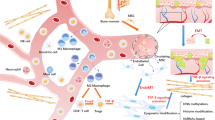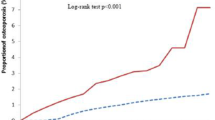Abstract
Background
Keloid is a fibrotic skin disease for which immune cell infiltration is a primary pathological hallmark. Meanwhile, in autoimmune diseases, triggering of the inflammation response can lead to tissue injury and subsequent organ fibrosis. When the skin is involved in autoimmune disease, skin fibrosis such as that seen in scleroderma can occur. In this study, we propose that keloid possesses features of autoimmune disease.
Methods
To verify whether keloid possesses features of autoimmune disease, immune cell infiltration and immune complex deposits were detected with immunohistochemical staining and immunofluorescence, respectively, in keloid and normal skin tissues. A routine antinuclear antibody profile was tested in sera from 28 keloid patients and 28 healthy controls. Lastly, the anti-hnRNPA2B1 autoantibody in sera was evaluated by enzyme-linked immunosorbent assay.
Results
The numbers of CD1α+ Langerhans cells, CD3+ T lymphocytes, CD68+ macrophages, and CD20+ B lymphocytes increased in keloid tissues compared to normal skin. IgA, IgM, C3, and C1q deposits were found in keloid tissues but not in normal skin, while anti-hnRNPA2B1 levels in sera from keloid patients were elevated.
Conclusion
The above findings suggest that keloids have some characteristics that are similar to autoimmune disease and might be mediated by autoimmune responses.
Level of Evidence IV
This journal requires that authors assign a level of evidence to each article. For a full description of these Evidence-Based Medicine ratings, please refer to the Table of Contents or the online Instructions to Authors www.springer.com/00266.



Similar content being viewed by others
References
Bran GM, Goessler UR, Hormann K, Riedel F, Sadick H (2009) Keloids: current concepts of pathogenesis (review). Int J Mol Med 24:283–293
Bayat A, McGrouther DA, Ferguson MW (2003) Skin scarring. BMJ 326:88–92
Brown BC, McKenna SP, Siddhi K, McGrouther DA, Bayat A (2008) The hidden cost of skin scars: quality of life after skin scarring. J Plast Reconstr Aesthet Surg 61:1049–1058
Bagabir R, Byers RJ, Chaudhry IH, Muller W, Paus R, Bayat A (2012) Site-specific immunophenotyping of keloid disease demonstrates immune upregulation and the presence of lymphoid aggregates. Br J Dermatol 167:1053–1066
Verhaegen PD, van Zuijlen PP, Pennings NM, van Marle J, Niessen FB, van der Horst CM, Middelkoop E (2009) Differences in collagen architecture between keloid, hypertrophic scar, normotrophic scar, and normal skin: an objective histopathological analysis. Wound Repair Regen 17:649–656
Kisseleva T, Brenner DA (2008) Mechanisms of fibrogenesis. Exp Biol Med (Maywood) 233:109–122
Stramer BM, Mori R, Martin P (2007) The inflammation-fibrosis link? A Jekyll and Hyde role for blood cells during wound repair. J Invest Dermatol 127:1009–1017
Detlefsen S, Brasen JH, Zamboni G, Capelli P, Kloppel G (2010) Deposition of complement C3c, immunoglobulin (Ig)G4 and IgG at the basement membrane of pancreatic ducts and acini in autoimmune pancreatitis. Histopathology 57:825–835
Peterson LS, Nelson AM, Su WP (1995) Classification of morphea (localized scleroderma). Mayo Clin Proc 70:1068–1076
Denton CP, Black CM, Abraham DJ (2006) Mechanisms and consequences of fibrosis in systemic sclerosis. Nat Clin Pract Rheumatol 2:134–144
Butler PD, Longaker MT, Yang GP (2008) Current progress in keloid research and treatment. J Am Coll Surg 206:731–741
Huo AP, Lin KC, Chou CT (2010) Predictive and prognostic value of antinuclear antibodies and rheumatoid factor in primary Sjogren’s syndrome. Int J Rheum Dis 13:39–47
De Rycke L, Baeten D, Kruithof E, Van den Bosch F, Veys EM, De Keyser F (2005) The effect of TNFalpha blockade on the antinuclear antibody profile in patients with chronic arthritis: biological and clinical implications. Lupus 14:931–937
Marin GG, Cardiel MH, Cornejo H, Viveros ME (2009) Prevalence of antinuclear antibodies in 3 groups of healthy individuals: blood donors, hospital personnel, and relatives of patients with autoimmune diseases. J Clin Rheumatol 15:325–329
Pisetsky DS (2011) Antinuclear antibodies in healthy people: the tip of autoimmunity’s iceberg? Arthritis Res Ther 13:109
Mayadas TN, Tsokos GC, Tsuboi N (2009) Mechanisms of immune complex-mediated neutrophil recruitment and tissue injury. Circulation 120:2012–2024
McCarty SM, Syed F, Bayat A (2010) Influence of the human leukocyte antigen complex on the development of cutaneous fibrosis: an immunogenetic perspective. Acta Derm Venereol 90:563–574
Seifert O, Mrowietz U (2009) Keloid scarring: bench and bedside. Arch Dermatol Res 301:259–272
Kazeem AA (1988) The immunological aspects of keloid tumor formation. J Surg Oncol 38:16–18
Bloch EF, Hall MG Jr, Denson MJ, Slay-Solomon V (1984) General immune reactivity in keloid patients. Plast Reconstr Surg 73:448–451
Cohen IK, McCoy BJ, Mohanakumar T, Diegelmann RF (1979) Immunoglobulin, complement, and histocompatibility antigen studies in keloid patients. Plast Reconstr Surg 63:689–695
Kischer CW, Shetlar MR, Shetlar CL, Chvapil M (1983) Immunoglobulins in hypertrophic scars and keloids. Plast Reconstr Surg 71:821–825
Yagi KI, Dafalla AA, Osman AA (1979) Does an immune reaction to sebum in wounds cause keloid scars? Beneficial effect of desensitisation. Br J Plast Surg 32:223–225
Janssen de Limpens AM, Cormane RH (1982) Keloids and hypertrophic scars–immunological aspects. Aesthetic Plast Surg 6:149–152
Dreyfuss G, Matunis MJ, Pinol-Roma S, Burd CG (1993) hnRNP proteins and the biogenesis of mRNA. Annu Rev Biochem 62:289–321
Caporali R, Bugatti S, Bruschi E, Cavagna L, Montecucco C (2005) Autoantibodies to heterogeneous nuclear ribonucleoproteins. Autoimmunity 38:25–32
Dangli A, Guialis A, Vretou E, Sekeris CE (1988) Autoantibodies to the core proteins of hnRNPs. FEBS Lett 231:118–124
Hassfeld W, Steiner G, Hartmuth K, Kolarz G, Scherak O, Graninger W, Thumb N, Smolen JS (1989) Demonstration of a new antinuclear antibody (anti-RA33) that is highly specific for rheumatoid arthritis. Arthritis Rheum 32:1515–1520
Siapka S, Patrinou-Georgoula M, Vlachoyiannopoulos PG, Guialis A (2007) Multiple specificities of autoantibodies against hnRNP A/B proteins in systemic rheumatic diseases and hnRNP L as an associated novel autoantigen. Autoimmunity 40:223–233
Neri R, Tavoni A, Cristofani R, Levanti C, Sodini G, d’Ascanio A, Vitali C, Ferri C, Bombardieri S (1992) Antinuclear antibody profile in Italian patients with connective tissue diseases. Lupus 1:221–227
Guevara-Gutierrez E, Yinh-Lao J, Garcia-Gutierrez P, Tlacuilo-Parra A (2010) Frequency of antinuclear antibodies in mestizo Mexican children with morphea. Clin Rheumatol 29:1055–1059
Preisz K, Sardy M, Horvath A, Karpati S (2005) Immunoglobulin, complement and epidermal transglutaminase deposition in the cutaneous vessels in dermatitis herpetiformis. J Eur Acad Dermatol Venereol 19:74–79
Shaker SA, Ayuob NN, Hajrah NH (2011) Cell talk: a phenomenon observed in the keloid scar by immunohistochemical study. Appl Immunohistochem Mol Morphol 19:153–159
Onodera M, Ueno M, Ito O, Suzuki S, Igawa HH, Sakamoto H (2007) Factor XIIIa-positive dermal dendritic cells in keloids and hypertrophic and mature scars. Pathol Int 57:337–342
Boyce DE, Ciampolini J, Ruge F, Murison MS, Harding KG (2001) Inflammatory-cell subpopulations in keloid scars. Br J Plast Surg 54:511–516
Lim PL, Zouali M (2006) Pathogenic autoantibodies: emerging insights into tissue injury. Immunol Lett 103:17–26
Benoist C, Mathis D (2000) A revival of the B cell paradigm for rheumatoid arthritis pathogenesis? Arthritis Res 2:90–94
Leandro MJ (2013) B-cell subpopulations in humans and their differential susceptibility to depletion with anti-CD20 monoclonal antibodies. Arthritis Res Ther 15(Suppl 1):S3
Bluml S, McKeever K, Ettinger R, Smolen J, Herbst R (2013) B-cell targeted therapeutics in clinical development. Arthritis Res Ther 15(Suppl 1):S4
Acknowledgments
This study was funded by National Natural Science Foundation of China (30871433, 31071305).
Author information
Authors and Affiliations
Corresponding author
Ethics declarations
Conflict of interest
The authors declare that they have no conflicts of interest to disclose.
Rights and permissions
About this article
Cite this article
Jiao, H., Fan, J., Cai, J. et al. Analysis of Characteristics Similar to Autoimmune Disease in Keloid Patients. Aesth Plast Surg 39, 818–825 (2015). https://doi.org/10.1007/s00266-015-0542-4
Received:
Accepted:
Published:
Issue Date:
DOI: https://doi.org/10.1007/s00266-015-0542-4




